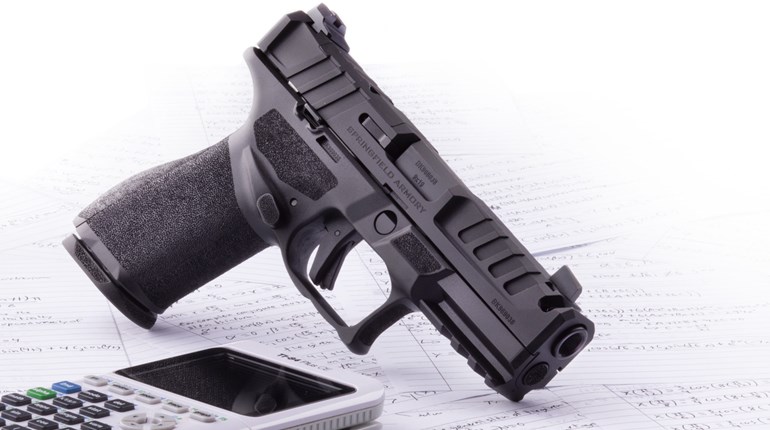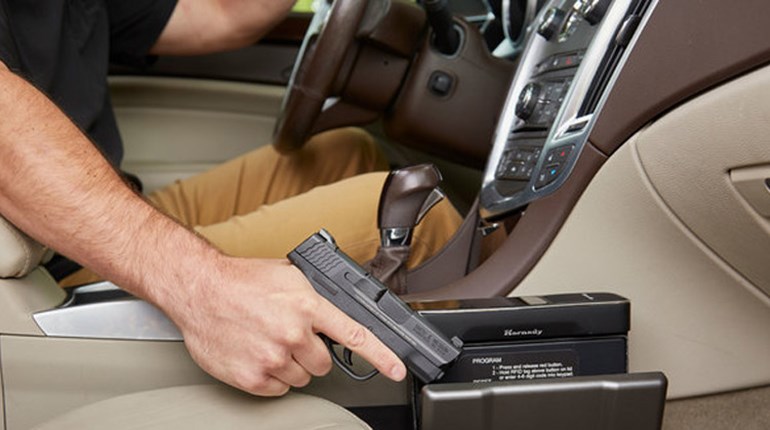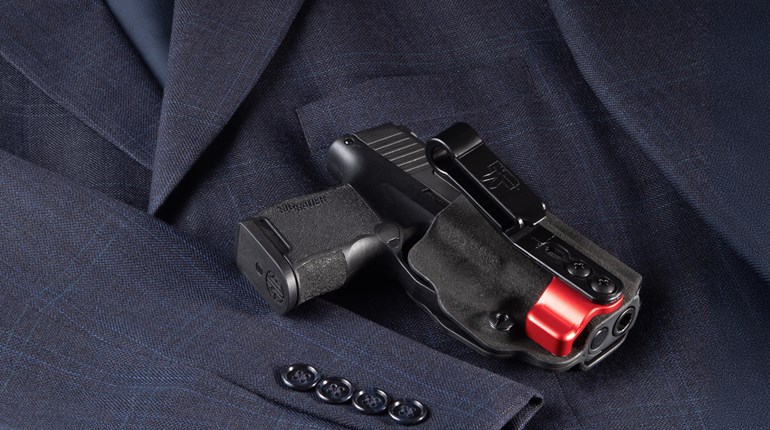
I don’t get to relax or go on vacation as much as I might like. When I do vacation, I love to travel throughout our great country, as there is much to see and much I have not yet seen. I make it a point to visit not just the common tourist sites, but the sites less traveled. I enjoy history and learning about where we came from and who we are as a republic. Sometimes I end up traveling to locations that can be described as less-than-gun-friendly to strictly anti-gun. I make a choice when I travel to these locations to be disarmed. It is less than ideal, but I want to say I have visited and learned firsthand about some of these wonderful locations.
When I travel to teach across our great country, I try to travel to more gun-friendly locations. Plus, living in such a gun-friendly state—the great state of Texas—has allowed me to grow a little comfortable with my loadout. Usually, I’m traveling with an assortment of guns to both demonstrate with and for my own self-defense. Since travel restrictions limit how much I can check-in at the airport counter, I have to be smart about what I pack.
Aside from the weight restrictions, I also have to consider the optimal tools to use in classes. On a recent vacation, I learned how poorly I planned. I have to find the right tool for the job, meaning I might have to consider other guns to carry. I need to have better supporting equipment, meaning more holster and carry options. Then, I need to consider my wardrobe and how I want to be comfortable and enjoy my vacation, meaning to live my life, but go armed in the process.
Since most of the classes I teach on the road are about concealed carry, I choose to bring guns optimally suited to address the masses. There are popular guns and then there are niche guns; I stick with the popular and prevailing platforms for concealed carry. Typically, this is a double-stack, striker-fired pistol chambered in 9 mm. These guns have sufficient capacity to deal with most violent encounters without having to perform a reload.
The 9 mm caliber is a good balance of terminal performance and capacity. Striker-fired guns are the most popular and for good reason, being easier for the casual shooter. When we start talking about makes/models, we see the Glock G19, Smith & Wesson M&P 2.0 Compact and SIG Sauer P320 Compact. I will float between these guns to give the students a broader understanding of their capabilities.
While double-stack, striker-fired guns seem to be getting the lion’s share of attention, there are others out there as well. So, I will bring additional blasters that fall more into the single-stack, striker-fired 9 mm or .380 ACP categories. These guns typically have less capacity and are a bit more challenging to shoot well. They are still popular and for good reason.
Popular opinion favors small when it comes to concealed carry. I like instructing with compact guns, but I put in time on these subcompacts as well. The makes/models we see are the Glock G43, Glock G48 and Smith & Wesson Shield. The challenges from these subcompacts are shorter sight radius for accuracy, reduced weight for recoil management and less-grippy surfaces for dealing with follow-up shots. Still, they are popular.
Then there are the diehards who enjoy lightweight, small revolvers. I’m a big fan, but only within the scope of work for which they are ideally suited: Close-up work. I am not saying they are not accurate, but the reduced capacity and reloading difficulty makes them less appealing. I still carry and instruct with a wheelgun, as they fit a narrow scope of work, within which they are awesome. I typically perform more of a demonstration so students can see the pros and cons of five-shot revolvers in real time. If you are going to carry a revolver for self-defense, then you will want to practice and practice often.
On a past vacation earlier this year, I literally went into teaching/travel mode and packed my same loadout minus a single stack. I did give it a brief moment of thought, but decided I would want enough of a gun since I would be away from home for so long and opted for a five-shot revolver as my backup. I have loaded out like this dozens of times without giving it a second thought. On this trip, it proved to be less than ideal and a good lesson to share. Once I was in the South Florida heat and humidity, my clothing options changed. The primary goal for concealed carry is to conceal, so this provided a difficult carry decision.
Instead of wishing for what I didn’t have, I started paying attention to what I had. The first thing I realized was bringing the five-shot revolver might have seemed like a great idea at the time. I turned to it as my primary for the majority of the trip, which meant at times I felt like I was lacking enough gun. Plus, carrying spare ammunition for the revolver became a requirement and not a suggestion.
While I wore lightweight, casual pants a lot, I wished I had brought my ankle holster, something I bring on my teaching trips, but not this vacation. This would have given me a better option for carrying that doesn’t get enough attention. While it is not as fast as drawing from a holster carried on the hip, it makes up for it in the convenience of carrying in different outfits I had on this trip.

Additionally, my go-to belt is pretty stiff. I like it because when you carry more than 80 percent of your waking hours, it is nice to have your gear supported with a good belt. However, I discovered it limited me to some extent. Don’t get me wrong, I would rather have a stiff belt for concealed carry, but I wish I had thrown in one of my lightweight, traditional belts I use. These two would have given me some different options for sure.
The biggest issue with the belt had more to do with comfort, as extended wear in the humid conditions made the stiff belt somewhat less agreeable. I talk about being comfortable in concealed-carry classes, because when you start off uncomfortable and add weather with long days it gets old real fast. It produces a state where you are constantly fidgeting, adjusting and telegraphing. A concealed-carry goal is avoid attracting attention to yourself. Hard to do when you are being worn raw in some places.
Probably my biggest lesson learned was taking my concealed-carry gear so lightly. The trips in the past were somewhat easy. Traveling to a totally anti-gun state meant I didn’t have to worry about my traditional equipment. I had to adapt and work on my improvised weaponry along with non-traditional options. Traveling to a less-gun-friendly state meant I could have, but not carry, and had magazine-capacity limitations. Again, this made it somewhat easy on my packing. Traveling to a gun-friendly state, though, I failed to give it sufficient thought. Looking back, I was a bit cocky, having traveled professionally so often it gave me a false sense of security.

I would change up my gear significantly to the point I would bring a subcompact as my primary, what I would be carrying the majority of the time in public. This relegated my compact to home-defense mode in the hotel. This also meant I had to have sufficient means to secure my home-defense gun while away, not trusting a “do not disturb” sign hung on the door.
My travel case, a hard-sided plastic case, worked great and, once secured, was placed within the hotel room safe or locked in the trunk of the rental car. In all this process it made me appreciate how important a good holster is even when not wearing it on my body. I would holster the gun, then secure it in the case. Ensuring your firearms are protected from unauthorized access is a full-time job.
Future vacation trips will more than likely include the SIG Sauer P365 or Springfield Armory Hellcat. Technically these qualify as subcompact, double-stack guns. Either gives me in excess of 10 rounds, with increased capacity magazines available, some up to 15 rounds to carry as a spare or reload. Holster options are getting better, and while I’m happy, I’m not completely content.
What holsters I do have are adequate for the scope of work on this type of trip. However, the holster market still hasn’t fully caught up with these little blasters. With such a small profile—and better holster options—either make a pretty solid choice. Then, I can opt for the SIG P320 Compact or the XD as the “home-defense” gun. While the larger guns are different from the small variants, each fire-control system will be more similar than changing brands.

I still had a great time, but I learned a lot. I learned not to get too comfortable with my traditional equipment even if it is my job. It works, but when I travel to the range, restaurant, gym then hotel it is pretty easy. Put some thought into what you will carry as your primary and be open to other options. Test an assortment of holster and carry options, then use the one best suited for the job. It is not a bad idea to have a couple for your trip just in case.
I had a lot of activities where I couldn’t carry, so having a good plan for how to secure the gun is just as important as when you are carrying. Consider non-traditional wardrobe and extreme-weather conditions first. It makes your packing a lot easier if you start from the worst case and go from there. In the end, we need time to relax and recharge, but we still are responsible for our personal safety.




































